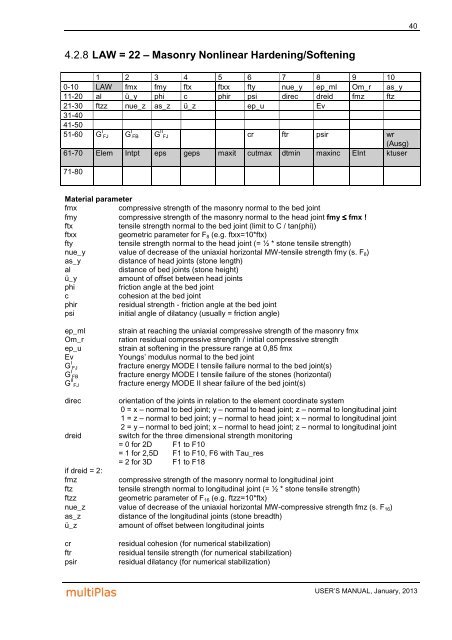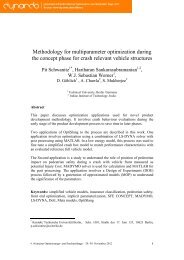multiPlas - Dynardo GmbH
multiPlas - Dynardo GmbH
multiPlas - Dynardo GmbH
You also want an ePaper? Increase the reach of your titles
YUMPU automatically turns print PDFs into web optimized ePapers that Google loves.
4.2.8 LAW = 22 – Masonry Nonlinear Hardening/Softening<br />
1 2 3 4 5 6 7 8 9 10<br />
0-10 LAW fmx fmy ftx ftxx fty nue_y ep_ml Om_r as_y<br />
11-20 al ü_y phi c phir psi direc dreid fmz ftz<br />
21-30 ftzz nue_z as_z ü_z ep_u Ev<br />
31-40<br />
41-50<br />
51-60 G I<br />
FJ<br />
G I<br />
FB<br />
61-70 Elem Intpt<br />
71-80<br />
G II<br />
FJ cr ftr psir wr<br />
(Ausg)<br />
eps geps maxit cutmax dtmin maxinc EInt ktuser<br />
Material parameter<br />
fmx compressive strength of the masonry normal to the bed joint<br />
fmy compressive strength of the masonry normal to the head joint fmy ≤ fmx !<br />
ftx tensile strength normal to the bed joint (limit to C / tan(phi))<br />
ftxx geometric parameter for F8 (e.g. ftxx=10*ftx)<br />
fty tensile strength normal to the head joint (= ½ * stone tensile strength)<br />
nue_y value of decrease of the uniaxial horizontal MW-tensile strength fmy (s. F8)<br />
as_y distance of head joints (stone length)<br />
al distance of bed joints (stone height)<br />
ü_y amount of offset between head joints<br />
phi friction angle at the bed joint<br />
c cohesion at the bed joint<br />
phir residual strength - friction angle at the bed joint<br />
psi initial angle of dilatancy (usually = friction angle)<br />
ep_ml strain at reaching the uniaxial compressive strength of the masonry fmx<br />
Om_r ration residual compressive strength / initial compressive strength<br />
ep_u strain at softening in the pressure range at 0,85 fmx<br />
Ev Youngs’ modulus normal to the bed joint<br />
G I<br />
FJ fracture energy MODE I tensile failure normal to the bed joint(s)<br />
G I<br />
FB fracture energy MODE I tensile failure of the stones (horizontal)<br />
G II<br />
FJ fracture energy MODE II shear failure of the bed joint(s)<br />
direc orientation of the joints in relation to the element coordinate system<br />
0 = x – normal to bed joint; y – normal to head joint; z – normal to longitudinal joint<br />
1 = z – normal to bed joint; y – normal to head joint; x – normal to longitudinal joint<br />
2 = y – normal to bed joint; x – normal to head joint; z – normal to longitudinal joint<br />
dreid switch for the three dimensional strength monitoring<br />
= 0 for 2D F1 to F10<br />
= 1 for 2,5D F1 to F10, F6 with Tau_res<br />
= 2 for 3D F1 to F18<br />
if dreid = 2:<br />
fmz compressive strength of the masonry normal to longitudinal joint<br />
ftz tensile strength normal to longitudinal joint (= ½ * stone tensile strength)<br />
ftzz geometric parameter of F16 (e.g. ftzz=10*ftx)<br />
nue_z value of decrease of the uniaxial horizontal MW-compressive strength fmz (s. F16)<br />
as_z distance of the longitudinal joints (stone breadth)<br />
ü_z amount of offset between longitudinal joints<br />
cr residual cohesion (for numerical stabilization)<br />
ftr residual tensile strength (for numerical stabilization)<br />
psir residual dilatancy (for numerical stabilization)<br />
40<br />
USER’S MANUAL, January, 2013






